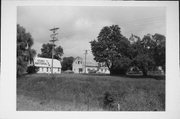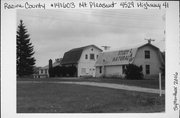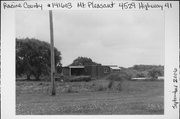| Additional Information: | 2006- The subject property consists of five buildings. Located adjacent to the driveway are two two-story, gambrel-roof buildings. Of these
two, the one closest to Highway 41/E. Frontage Road features sheet metal sheathing and one-over-one, double-hung sash
windows. Painted on the building's gambrel roof is the message "Study Natural Law." Located behind this building, the second
gambrel-roof building is sheathed with modern insulation panels and contains multi-light wood sash windows and a modern double
door entrance on the primary (west) facade. A gabled wing located on the rear (east) elevation of the building features multi-light
metal sash windows. This latter building was formerly a barn that has been converted into the University chapel. Situated further
back on the property is a one-story, brick residential building that has a flat-roof and a large, projecting metal sash window. A
modern lean-to addition has been built onto the side (north) elevation. A large wind generator formerly located in front of this
building has been removed within the past decade. Finally, two, one-story, gabled, brick utilitarian buildings are located toward the
eastern property boundary. A contemporary sheet metal sign identifying the property as the University of Lawsonomy faces Highway
41/E. Frontage Road. (A 'No Trespassing' sign affixed to a chain that spans the driveway bars access to the property).
The origins of the University of Lawsonomy begin with Alfred W. Lawson. Born in March 1869, Lawson was a professional baseball
player and aviation pioneer before he became involved in economic and societal reforms with the founding of the Humanity
Benefactor Foundation and Direct Credits Society in Detroit. His economic system - based on eliminating financiers and abolishing
the interest on debt, while the government would issue direct credits, or interest-free loans, to all people - received a large
following. Thousands of people were attracted to Direct Credits Society mass meetings and lectures that were held in multiple
Midwestern cities. Lawson's Direct Credits Society ultimately boasted over a million members and its publication, The Benefactor,
was issued in ten different languages claiming a circulation of seven million. Not satisfied with limiting himself to the economic
arena, Lawson developed the doctrine of Lawsonomy, which encompassed scientific beliefs, moral philosophies and religious
decrees. The basic principles of Lawsonomy were that the universe consisted of neither energy nor empty space, but substances of
varying density, which achieved movement through suction and pressure. Further, life featured conflicting forces; namely, the
menorgs, which bring humanity closer to God, and the opposing disorgs. Lawson felt the degraded state of humanity was attributed
to the increasing influence of the disorgs and the study of Lawsonomy would secure a permanent improvement in human nature.
Lawson's Humanity Benefactor Foundation published his writings and, in practice, adherence to Lawsonomy included
vegetarianism, abstinence from liquor and tobacco, and dunking one's head in cold water among other practices. In order to spread
the Lawsonomy movement, in 1943 the Humanity Benefactor Foundation purchased a defunct university campus in Des Moines,
Iowa, consisting of six buildings situated on fourteen acres. Named the Des Moines University of Lawsonomy, tuition was free and
the academic curriculum consisted solely of studying Lawson's writings (other books were not allowed on campus). Enrollment at
the University was small.and, at its peak in the mid-1940s, the University of Lawsonomy had between 50-60 students.
The relocation of the University of Lawsonomy from Des Moines to the subject property appears to have come about due to a
convergence of events. Purchased by Lawson's Humanity Benefactor Foundation in 1951, the property was originally referred to as
the Des Moines University of Lawsonomy Farm and was intended to be used for the implementation of Lawson's farming principles
(Lawson authored the book, Gardening: A Text Book for Des Moines University, which the Humanity Benefactor Foundation
published in 1943). In 1954, a Memorial Day weekend reunion for former Lawsonomy students (many of whom resided in the
Midwest) was held at the farm and attended by Alfred Lawson. A few months later, due to internal and external pressures that
included a lack of students, failure to pay local taxes, and a settlement with the federal government over the acquisition and
reselling of war-surplus machine tools, the sale of the Des Moines University of Lawsonomy was announced. Although Lawson
indicated in an interview he gave at this time that the University would relocate to a yet undetermined location, associates of his
later stated he had given up on the university model and, instead, was creating a plan where his followers would move en masse to
a neighborhood in California where they would purchase their own homes while maintaining social, religious and educational
facilities in common. Before he could fulfill any future intentions, Alfred Lawson died in November 1954. The relocation of the
University of Lawsonomy to the subject property in 1956 was likely the result of these aforementioned events: the sale of the
property in Des Moines; the fact that the University already owned the subject farm; and, most significantly, the lack of direction
provided by Lawson prior to his death. The Lawsonomists did construct a dormitory on the property (the brick building) in 1960 and
a wind generator (since removed). They also converted the existing barn into a chapel, while using the other main building as a
machine shop. However, the Lawsonomy movement saw few converts following Alfred Lawson's death and these individuals were
generally born into Lawsonomy families. The University never had more than a few individuals living at the property and it survived
on donations and the resourcefulness of these residents who did not receive a salary and grew their own food. By 1965, only three
people resided at the University of Lawsonomy and these were the University officials/caretakers, although annual reunions
continued to draw former students to the property for a number of years.
-"I-94" WisDOT ID #1030-20-00, Prepared by Heritage Research, Ltd (McQuillen) (2006).
May 2017: A few small changes have occurred to this property since it was surveyed in 2006. The roof on the building adjacent to the highway has been reshingled, thus does message to "Study Natural Law" that was apparent in 2006 no longer appear. As well, the very large sign facing the highway identifying the property as the "University of Lawsonomy" has been removed. dormitory |
|---|



